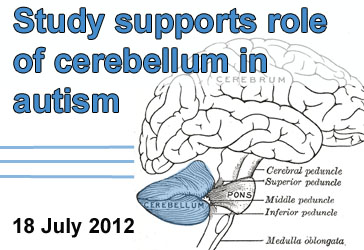Archives
July, 2012
Select a different month in the archive
Oxytocin May Improve Social Interaction in Autism
By Catherine Croft Swanwick, Ph.D. on July 26, 2012

Overview: New evidence suggests that administration of the neuropeptide oxytocin may improve social interaction among people with Autism Spectrum Disorders (ASD).
Background: Oxytocin is well known as a neuropeptide which shapes social behavior. Its expression is regulated by parent-infant bonding and variants of its gene, OXTR, have been linked to ASD.
What’s New: Two recent studies show that an oxytocin nose spray affects social interaction. One research team showed that ASD individuals who took the oxytocin nose spray improved their ability to discriminate non-verbal social cues and increased their attention to other people’s eyes. Another research group demonstrated that fathers who took the oxytocin nose spray bonded more with their infant during a play session, leading to enhanced oxytocin expression and social interaction in the infant, as well.
Why it’s Important: This evidence provides support for the therapeutic potential of oxytocin for ASD. Moreover, oxytocin delivery to the parent instead of the infant may still enhance social behaviors in infants at risk for ASD. However, it should be noted that effects of the oxytocin nose spray are short-lived and may vary among individuals depending on ASD symptoms and severity.
Help me understand :
| Source(s) : |
| Tweet |
TSC1 Evidence Shows Role for Cerebellum in Autism
By Catherine Croft Swanwick, Ph.D. on July 18, 2012

Background: Scientists have long been searching for neural circuits underlying ASD. One suspected player is the cerebellum, a brain region important for balance and movement. Among the various pieces of evidence linking the cerebellum to ASD is the observation that cerebellar pathology is a common feature of individuals with Tuberous Sclerosis Complex (TSC), a genetic disorder in which many individuals also display symptoms of autism. TSC is caused by variants of the genes TSC1 and TSC2, which inhibit signaling of the mTOR pathway.
What’s New: Researchers genetically engineered mice which did not express TSC1 in their cerebellum. These mice displayed ASD-like behaviors, including abnormal social interaction and repetitive behavior/vocalizations. They also showed abnormal function of Purkinje cells, a major cell type of the cerebellum. Treatment of the mice with rapamycin, a drug which inhibits mTOR signaling, prevented the ASD-like behaviors and cerebellar dysfunction.
Why it’s Important: This evidence provides support for the role of the cerebellum in ASD. It also demonstrates roles for TSC1 in cerebellar function.
Help me understand :
| Source(s) : |
| Tweet |

